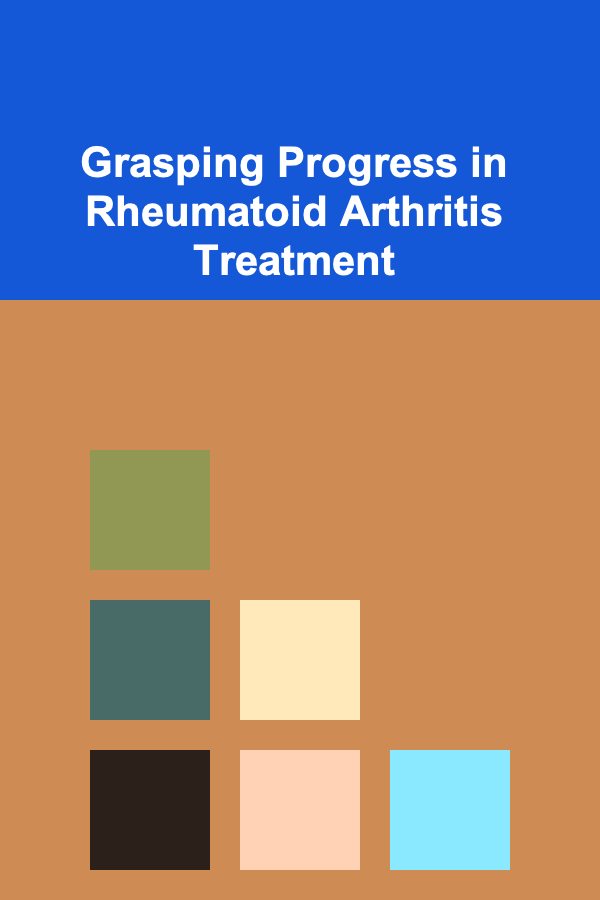
Grasping Progress in Rheumatoid Arthritis Treatment
ebook include PDF & Audio bundle (Micro Guide)
$12.99$7.99
Limited Time Offer! Order within the next:

Rheumatoid arthritis (RA) is a chronic autoimmune disease that primarily affects the joints, leading to inflammation, pain, stiffness, and eventual joint damage. While there's currently no cure for RA, significant advancements in treatment strategies over the past few decades have revolutionized the management of the disease. Patients today have a much better chance of achieving remission or low disease activity and maintaining a good quality of life compared to previous generations. However, effectively navigating these advances requires a comprehensive understanding of the available treatment options, monitoring strategies, and the importance of a patient-centered approach.
Understanding the Landscape of RA Treatment
Grasping progress in RA treatment necessitates a clear understanding of the historical context, current treatment paradigms, and future directions. The evolution of RA treatment can be broadly categorized into distinct eras, each marked by the introduction of novel therapeutic strategies and a shift in treatment goals.
The Pre-Biologic Era: Foundational Therapies
Before the advent of biologic therapies, the mainstay of RA treatment revolved around traditional Disease-Modifying Antirheumatic Drugs (DMARDs) and symptomatic relief. These therapies include:
- Nonsteroidal Anti-Inflammatory Drugs (NSAIDs): NSAIDs like ibuprofen and naproxen provide symptomatic relief by reducing pain and inflammation. However, they do not address the underlying disease process and are associated with potential gastrointestinal, cardiovascular, and renal side effects. Their role is now primarily adjunct, used for short-term flare control or alongside DMARDs.
- Corticosteroids: Corticosteroids such as prednisone are potent anti-inflammatory agents that can quickly alleviate RA symptoms. However, long-term use is associated with significant adverse effects, including osteoporosis, weight gain, increased risk of infection, and cardiovascular problems. Consequently, corticosteroids are ideally used for short-term bridging therapy or during acute flares, with careful monitoring and dose tapering.
- Traditional DMARDs: These drugs, like methotrexate, sulfasalazine, hydroxychloroquine, and leflunomide, are cornerstone of RA treatment. They work by suppressing the immune system and slowing down disease progression. Methotrexate is often the first-line DMARD due to its efficacy, relatively favorable safety profile, and ease of administration. Combination therapy with multiple traditional DMARDs can sometimes be more effective than monotherapy. The mechanism of action for many of these drugs is not fully understood, adding to the complexity of their use.
Despite their effectiveness in some patients, traditional DMARDs often fail to achieve adequate disease control in a significant proportion of individuals, necessitating the development of more targeted therapies.
The Biologic Era: Targeting Specific Immune Pathways
The introduction of biologic DMARDs (bDMARDs) marked a paradigm shift in RA treatment. These drugs are genetically engineered proteins that specifically target key molecules involved in the inflammatory cascade. Biologics have revolutionized the treatment of RA, enabling many patients to achieve remission or low disease activity who previously had limited options. The major classes of biologics include:
- Tumor Necrosis Factor (TNF) inhibitors: TNF is a key cytokine that drives inflammation in RA. TNF inhibitors, such as etanercept, infliximab, adalimumab, golimumab, and certolizumab pegol, block the activity of TNF, thereby reducing inflammation and joint damage. These were the first biologics approved for RA and have a long track record of efficacy and safety. However, they increase the risk of infections, particularly tuberculosis, and require careful screening before initiation.
- Interleukin-6 (IL-6) inhibitors: IL-6 is another pro-inflammatory cytokine that plays a crucial role in RA pathogenesis. IL-6 inhibitors, such as tocilizumab and sarilumab, block the IL-6 receptor, thereby inhibiting IL-6 signaling. These drugs are effective in patients who have not responded adequately to TNF inhibitors. Side effects can include elevated cholesterol levels and increased risk of gastrointestinal perforations in some individuals.
- Interleukin-1 (IL-1) inhibitor: Anakinra blocks IL-1, another inflammatory cytokine, but it is generally less effective than TNF inhibitors or IL-6 inhibitors and is rarely used as a first-line biologic in RA.
- T-cell costimulation inhibitor: Abatacept inhibits T-cell activation by blocking the interaction between CD80/CD86 molecules on antigen-presenting cells and CD28 on T cells. It is an alternative option for patients who have failed TNF inhibitors or other biologics.
- B-cell depleting agent: Rituximab depletes B cells by targeting the CD20 protein on their surface. B cells play a key role in antibody production and inflammation in RA. Rituximab is typically used in combination with methotrexate and is effective in patients who have not responded to TNF inhibitors. Infusion reactions are a potential side effect.
The availability of multiple biologics has allowed for a more personalized approach to RA treatment, with clinicians able to select the most appropriate agent based on individual patient characteristics and disease activity. However, biologics are generally more expensive than traditional DMARDs and require careful monitoring for potential side effects.
The Targeted Synthetic DMARD Era: Precision Medicine
The latest advancement in RA treatment is the development of targeted synthetic DMARDs (tsDMARDs), also known as Janus kinase (JAK) inhibitors. These drugs are small molecules that inhibit the activity of JAK enzymes, which are intracellular signaling molecules involved in the inflammatory pathways. JAK inhibitors offer the advantage of oral administration, unlike biologics which are typically given by injection or infusion. The available JAK inhibitors include:
- Tofacitinib: A pan-JAK inhibitor that blocks JAK1, JAK2, JAK3, and TYK2.
- Baricitinib: Primarily inhibits JAK1 and JAK2.
- Upadacitinib: Primarily inhibits JAK1.
- Filgotinib: Primarily inhibits JAK1. (Note: Filgotinib's availability may vary by region.)
JAK inhibitors have demonstrated efficacy comparable to biologics in clinical trials. However, they have been associated with an increased risk of certain adverse events, including herpes zoster, venous thromboembolism, and elevated cholesterol levels. Recent FDA warnings have highlighted the need for caution when prescribing JAK inhibitors, particularly in older adults and those with cardiovascular risk factors. Careful risk-benefit assessment is crucial before initiating treatment with JAK inhibitors.
Monitoring Progress in RA Treatment
Effective management of RA requires continuous monitoring of disease activity and treatment response. This involves a combination of clinical assessments, laboratory tests, and patient-reported outcomes. Regular monitoring allows for timely adjustments to the treatment plan to optimize disease control and minimize the risk of complications.
Clinical Assessment
A thorough clinical assessment is essential for evaluating disease activity and treatment response. The assessment typically includes:
- Joint examination: Assessing the number of tender and swollen joints is a key component of disease activity scoring.
- Pain assessment: Using a visual analog scale (VAS) or numerical rating scale (NRS) to quantify pain intensity.
- Global assessment: The patient and physician provide an overall assessment of disease activity on a scale from 0 to 10.
- Functional assessment: Evaluating the patient's ability to perform daily activities using questionnaires such as the Health Assessment Questionnaire Disability Index (HAQ-DI).
Laboratory Tests
Laboratory tests play a crucial role in monitoring inflammation and assessing the impact of RA on other organ systems. Commonly used laboratory markers include:
- Erythrocyte sedimentation rate (ESR) and C-reactive protein (CRP): These are markers of systemic inflammation. Elevated levels indicate active inflammation, while a decrease in levels suggests a response to treatment.
- Rheumatoid factor (RF) and anti-citrullinated protein antibody (ACPA): These are autoantibodies associated with RA. While they are helpful in diagnosis, their levels do not always correlate with disease activity.
- Complete blood count (CBC): To monitor for anemia, leukopenia, or thrombocytopenia, which can be associated with RA or its treatment.
- Liver and kidney function tests: To assess the impact of RA and its treatment on these organs.
- Lipid panel: To monitor for dyslipidemia, which can be associated with RA and its treatment, particularly with IL-6 inhibitors and some JAK inhibitors.
Disease Activity Scores
Disease activity scores are composite measures that combine clinical and laboratory data to provide a quantitative assessment of disease activity. These scores are used to track treatment response and guide treatment decisions. Commonly used disease activity scores include:
- Disease Activity Score 28 (DAS28): Calculated using the number of tender and swollen joints, ESR or CRP, and the patient's global assessment of disease activity. DAS28 scores range from 0 to 9.4, with higher scores indicating greater disease activity.
- Simplified Disease Activity Index (SDAI): A simple additive score that includes the number of tender and swollen joints, patient's global assessment, physician's global assessment, and CRP.
- Clinical Disease Activity Index (CDAI): Similar to SDAI, but does not include CRP.
These scores help categorize patients into different disease activity states, such as remission, low disease activity, moderate disease activity, and high disease activity. The target of treatment is typically remission or low disease activity.
Patient-Reported Outcomes (PROs)
Patient-reported outcomes (PROs) capture the patient's perspective on their disease and treatment. These measures provide valuable information about the impact of RA on the patient's quality of life, function, and well-being. Commonly used PROs include:
- Health Assessment Questionnaire Disability Index (HAQ-DI): A measure of functional disability that assesses the patient's ability to perform daily activities.
- Patient Global Assessment of Disease Activity: The patient's overall assessment of their disease activity on a scale from 0 to 10.
- Pain Visual Analog Scale (VAS): A measure of pain intensity on a scale from 0 to 100 mm.
- Fatigue Severity Scale (FSS): A measure of fatigue severity.
PROs are increasingly recognized as important outcomes in RA clinical trials and clinical practice. They provide a more complete picture of the patient's experience with RA and can help guide treatment decisions.
Imaging
Imaging techniques, such as X-rays, ultrasound, and magnetic resonance imaging (MRI), can be used to assess joint damage and inflammation. X-rays can detect bone erosions and joint space narrowing, while ultrasound and MRI can detect synovitis, tenosynovitis, and early cartilage damage. Imaging is particularly useful for monitoring disease progression and identifying structural damage that may not be apparent on clinical examination.
Treatment Strategies: Tailoring Therapy to the Individual
The optimal treatment strategy for RA should be tailored to the individual patient's characteristics, disease activity, and risk factors. The treat-to-target (T2T) approach is a widely accepted strategy that emphasizes the importance of setting a specific treatment target (typically remission or low disease activity) and adjusting therapy until that target is achieved.
Treat-to-Target (T2T) Approach
The T2T approach involves the following steps:
- Establish a treatment target: The target is typically remission or low disease activity, as defined by a specific disease activity score (e.g., DAS28 < 2.6).
- Initiate treatment: Typically, treatment is initiated with methotrexate or another traditional DMARD.
- Monitor disease activity regularly: Disease activity is monitored using clinical assessments, laboratory tests, and patient-reported outcomes. The frequency of monitoring depends on disease activity and treatment response.
- Adjust treatment as needed: If the treatment target is not achieved within a specified timeframe (e.g., 3-6 months), treatment is adjusted. This may involve increasing the dose of the DMARD, adding another DMARD, or switching to a biologic or JAK inhibitor.
- Maintain treatment target: Once the treatment target is achieved, treatment is maintained to prevent flares and disease progression. However, dose tapering or discontinuation of therapy may be considered in patients who have been in sustained remission.
The T2T approach has been shown to improve outcomes in RA patients compared to traditional approaches that do not emphasize a specific treatment target.
Combination Therapy
Combination therapy with multiple DMARDs or with a DMARD plus a biologic or JAK inhibitor is often more effective than monotherapy in achieving disease control. Commonly used combination therapies include:
- Methotrexate plus another traditional DMARD: For example, methotrexate plus sulfasalazine and hydroxychloroquine (triple therapy).
- Methotrexate plus a TNF inhibitor: This is a common and effective combination therapy.
- Methotrexate plus an IL-6 inhibitor: Another effective combination therapy.
- Methotrexate plus a JAK inhibitor: While effective, recent safety concerns have led to more cautious use of this combination, particularly in older adults and those with cardiovascular risk factors. The FDA has issued warnings regarding the increased risk of serious cardiovascular events, malignancy, thrombosis, and death with certain JAK inhibitors, especially when used in combination with methotrexate.
The choice of combination therapy depends on the patient's individual characteristics, disease activity, and risk factors. Careful monitoring for side effects is essential with combination therapy.
Non-Pharmacological Therapies
Non-pharmacological therapies play an important role in managing RA symptoms and improving quality of life. These therapies include:
- Physical therapy: To improve joint mobility, muscle strength, and function.
- Occupational therapy: To adapt daily activities to reduce joint stress and improve independence.
- Exercise: Regular exercise, including aerobic exercise and strength training, can improve cardiovascular health, reduce pain, and improve function.
- Weight management: Maintaining a healthy weight can reduce stress on joints and improve overall health.
- Smoking cessation: Smoking is associated with increased risk of RA and worse disease outcomes.
- Stress management: Stress can exacerbate RA symptoms. Techniques such as yoga, meditation, and deep breathing can help manage stress.
- Assistive devices: Splints, braces, and other assistive devices can help support joints and reduce pain.
The Importance of Patient Education and Shared Decision-Making
Patient education and shared decision-making are essential for successful RA management. Patients who are well-informed about their disease and treatment options are more likely to adhere to their treatment plan and achieve better outcomes.
Patient Education
Patient education should cover the following topics:
- Understanding RA: The causes, symptoms, and potential complications of RA.
- Treatment options: The benefits and risks of different treatment options, including DMARDs, biologics, JAK inhibitors, and non-pharmacological therapies.
- Importance of adherence: The importance of taking medications as prescribed and attending regular follow-up appointments.
- Side effects: Potential side effects of medications and how to manage them.
- Self-management strategies: Techniques for managing pain, fatigue, and other symptoms.
- Resources: Information about support groups, online resources, and other resources for people with RA.
Shared Decision-Making
Shared decision-making involves a collaborative process between the patient and the physician, where both parties share information and preferences to arrive at a mutually agreeable treatment plan. This process ensures that the patient's values and goals are taken into account when making treatment decisions. Shared decision-making can improve patient satisfaction, adherence, and outcomes.
Future Directions in RA Treatment
Research in RA is rapidly advancing, with the goal of developing more effective and targeted therapies. Future directions in RA treatment include:
- Personalized medicine: Developing biomarkers to predict treatment response and identify patients who are most likely to benefit from specific therapies.
- New drug targets: Identifying new molecular targets in the inflammatory pathways that can be targeted with novel therapies.
- Regenerative medicine: Developing therapies to repair damaged cartilage and bone in RA joints.
- Prevention: Identifying risk factors for RA and developing strategies to prevent the disease from developing.
- Biosimilars: The increasing availability of biosimilars for existing biologics offers the potential to reduce treatment costs and improve access to care. However, careful consideration of interchangeability and immunogenicity is necessary.
Conclusion
Significant progress has been made in the treatment of RA over the past few decades. With the advent of biologic and targeted synthetic DMARDs, many patients can now achieve remission or low disease activity and maintain a good quality of life. However, effective management of RA requires a comprehensive understanding of the available treatment options, monitoring strategies, and the importance of a patient-centered approach. By adopting the treat-to-target approach, utilizing combination therapy when necessary, incorporating non-pharmacological therapies, and prioritizing patient education and shared decision-making, clinicians can optimize outcomes for patients with RA. Continued research and innovation hold the promise of even more effective and personalized therapies in the future, ultimately leading to improved outcomes and a better quality of life for individuals living with RA. It is critical to remember that RA treatment is an ongoing process that requires continuous monitoring and adjustments. The best approach involves close collaboration between the patient and their healthcare team to achieve the optimal level of disease control. Furthermore, staying informed about the latest advancements in RA treatment and actively participating in one's own care are essential steps in successfully managing this chronic condition. The information presented here is for general knowledge and informational purposes only, and does not constitute medical advice. It is essential to consult with a qualified healthcare professional for any health concerns or before making any decisions related to your health or treatment.

How to Maintain Your Rental Property on a Budget
Read More
How to Reduce Monthly Home Expenses by Downsizing
Read More
How to Use Deep Learning to Build Profitable AI Solutions
Read More
How to Use Pinterest for Library Inspiration and Ideas
Read More
How to Print Functional Parts with 3D Printing
Read More
How To Photograph Babies and Children: A Comprehensive Guide
Read MoreOther Products

How to Maintain Your Rental Property on a Budget
Read More
How to Reduce Monthly Home Expenses by Downsizing
Read More
How to Use Deep Learning to Build Profitable AI Solutions
Read More
How to Use Pinterest for Library Inspiration and Ideas
Read More
How to Print Functional Parts with 3D Printing
Read More